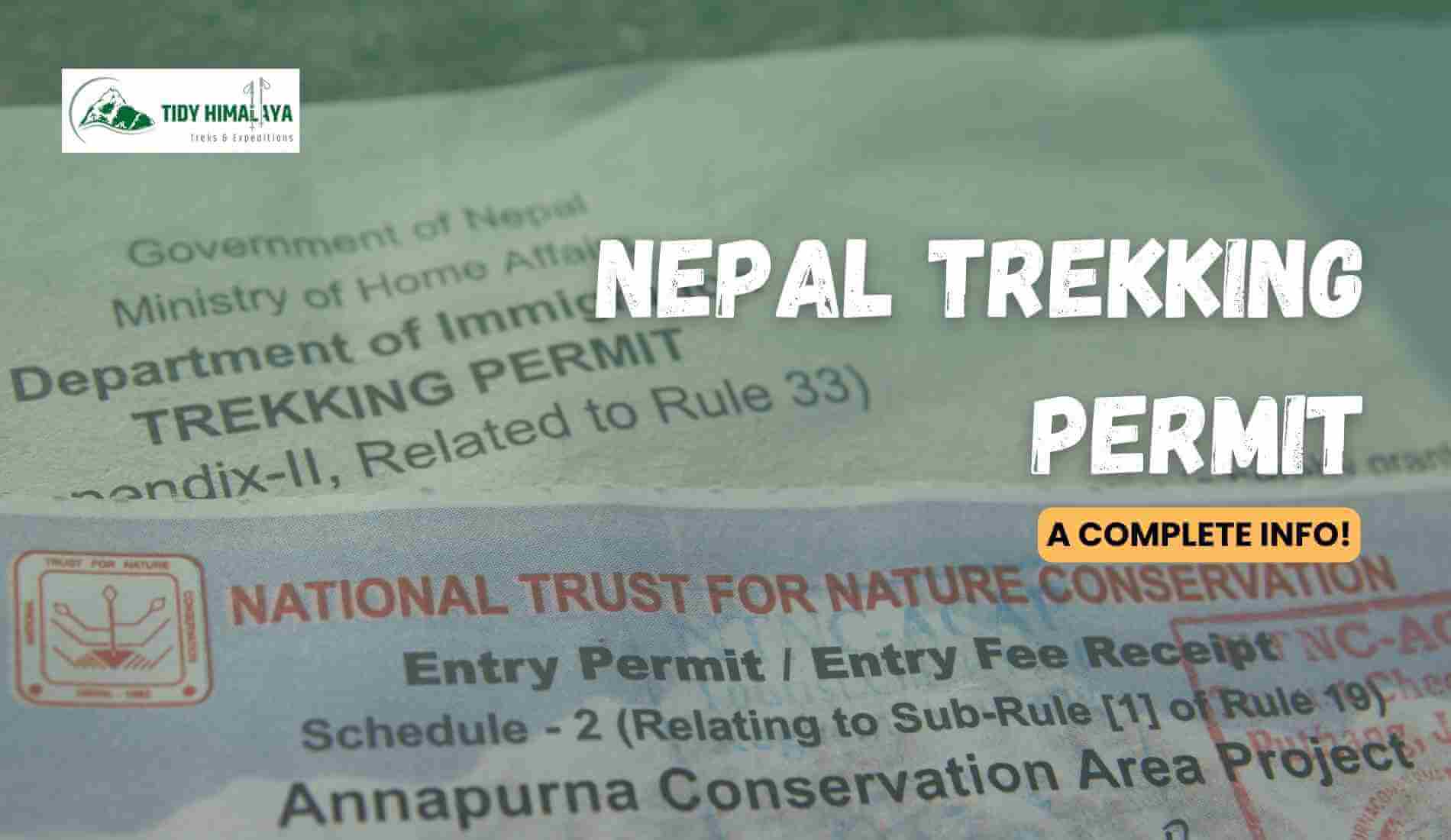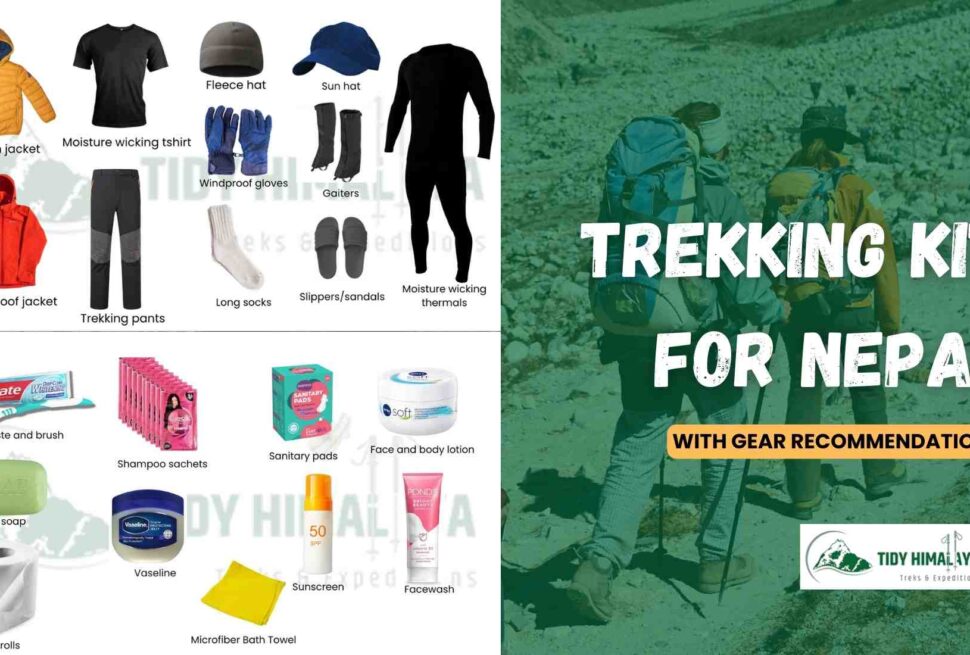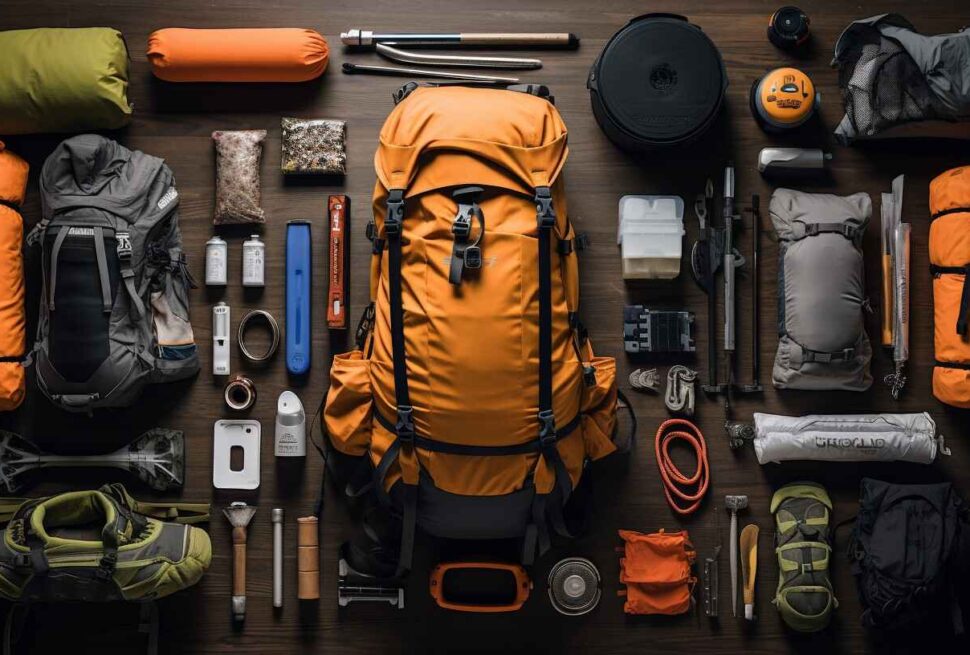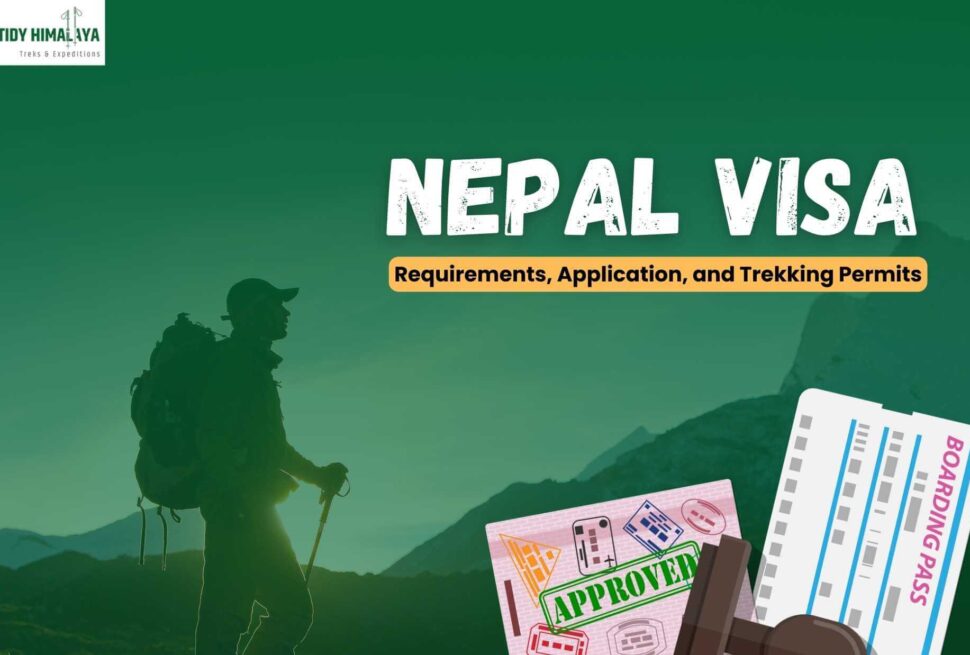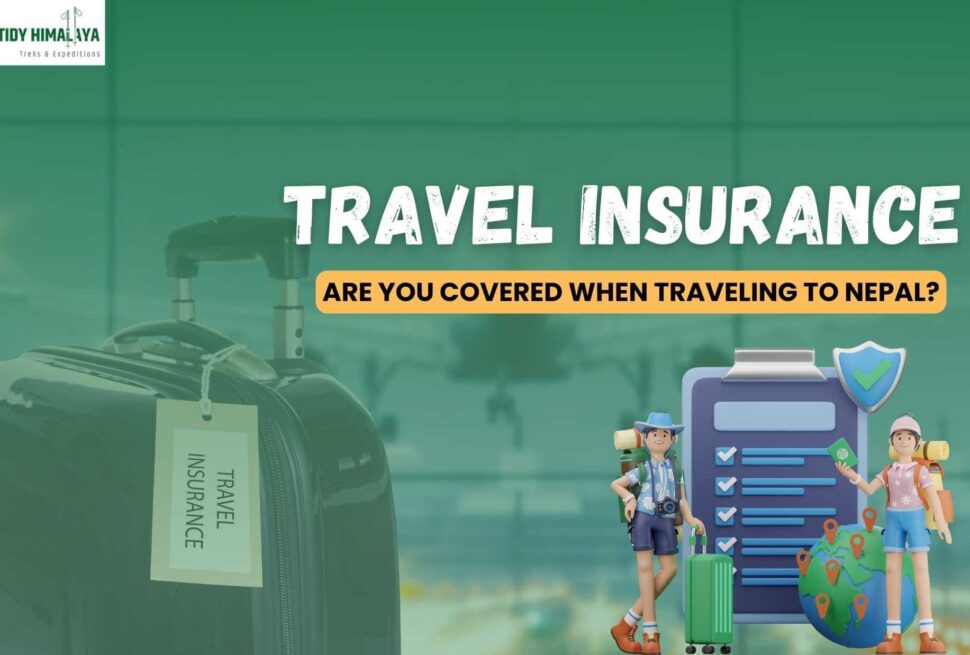With its towering mountains and rich cultural heritage, Nepal is the perfect destination for trekking adventures. Home to eight of the world’s ten highest peaks, including the famous Mount Everest, Nepal offers some of the most breathtaking and diverse trekking trails you’ll ever experience. Known as the land of mountains, Nepal boasts numerous peaks soaring above 8,000 meters, surrounded by stunning landscapes rich in natural resources.
You’ll need to obtain a trekking permit as you explore these stunning landscapes, from lush valleys to snow-capped summits. This permit helps protect the environment, ensures your safety on the trails, and supports the local communities you visit.
Why Trekking Permits Are Necessary in Nepal?
Trekking permits are essential for ensuring the safety and well-being of trekkers while preserving Nepal’s natural and cultural heritage. They help manage and monitor the number of trekkers on the trails, reducing environmental impact and maintaining the pristine condition of the landscapes.
Permit fees support local communities by funding infrastructure improvements and essential services, ensuring that the trekking regions remain sustainable and well-maintained.
Additionally, permits allow authorities to track trekkers’ movements, facilitating timely search and rescue operations in case of emergencies.
Types Of Trekking Permits And Fees
1. TIMS Card
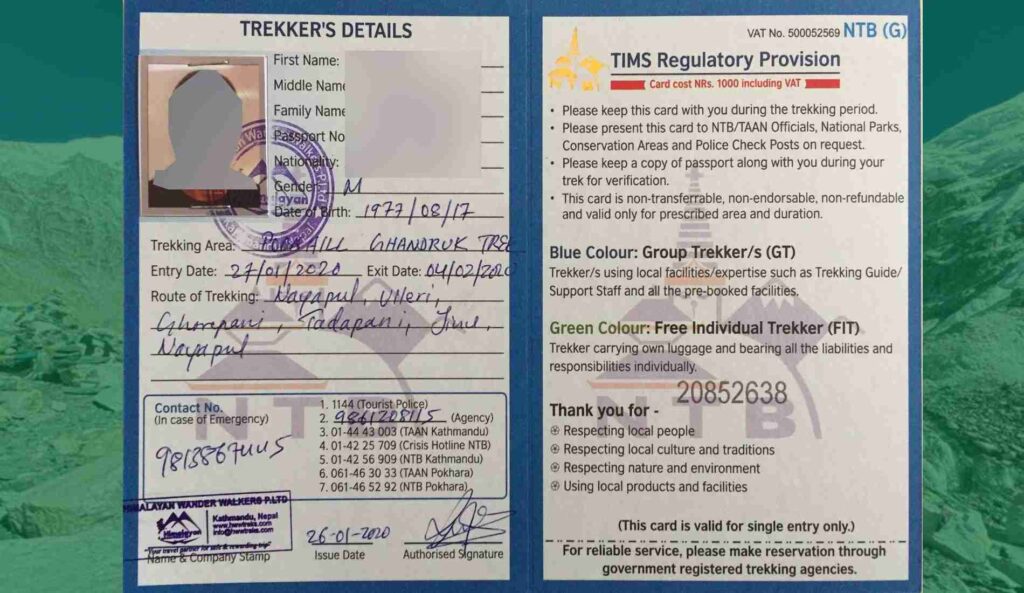
A TIMS (Trekkers’ Information Management System) card is a mandatory permit for trekkers in Nepal. It ensures trekkers’ safety by allowing authorities to track their movements and provide assistance in emergencies. Required for most Nepal trekking regions, the TIMS card helps manage and monitor trekking activities, promoting responsible and sustainable trekking.
Cost And Process Of Obtaining A TIMS Card
- Cost:
- NPR 1,000 for trekkers from SAARC countries.
- NPR 2,000 for trekkers from other countries.
- Where to Get It:
- Kathmandu: The Nepal Tourism Board office is on Pradarshani Marg, a twenty-minute walk from the Thamel tourist area. Open daily from 9 am to 5 pm (closed from 1-2 pm). The last permit application is at 4 pm.
- Pokhara: TAAN Lakeside office in Santi Patan. Hours are the same as in Kathmandu.
- Other Locations: Permit Nepal Trust and Restricted Area Permit offices.
- Required Documents:
- Photocopy of your passport information pages.
- Two passport-sized photos.
- Trekking details: start and end dates, entry and exit points, route, and itinerary.
- Insurance details: policy number, coverage for trekking at altitude, and emergency phone number of the insurance company.
- Emergency contact information: contact number and address in Nepal (trekking company/hotel) and an emergency contact number in your home country.
2. Restricted-Area Trekking Permits
Some areas in Nepal are heavily regulated to safeguard their natural beauty, cultural heritage, and environment. To visit these protected regions, tourists must make special arrangements and secure a restricted-area permit from the authorities. These regions have been accessible to tourists since October 1991.
Cost And Specific Regions That Require These Permits
The cost of restricted-area permits varies based on the region and the duration of the trek. Below are some specific regions and their associated permit costs:
- Upper Mustang: USD 500 for the first 10 days, with an additional USD 50 per day thereafter.
- Manaslu: USD 70 per week for the first week and USD 10 per day for each additional day.
- Dolpo (Upper Dolpo): USD 500 for the first 10 days, with an additional USD 50 per day thereafter.
- Kanchenjunga: USD 20 per week.
- Humla: USD 50 per week.
- Nar Phu Valley: USD 100 per week.
Process Of Obtaining Restricted-Area Permits
To obtain a restricted-area permit, you must go through an authorized trekking agency registered in Nepal, such as Tidy Himalaya. These permits can only be obtained from the Department of Immigration in Kathmandu through these authorized agencies.
To start the process, provide the trekking agency with a photocopy of your passport, passport-sized photos, and a detailed trekking itinerary. Pay the required fees, which vary based on the region and duration of your trek. The trekking agency will handle all the necessary paperwork and apply to the Department of Immigration on your behalf. Once processed, the agency will provide you with the restricted-area permit you must carry during your trek.
3. Conservation Area Permits
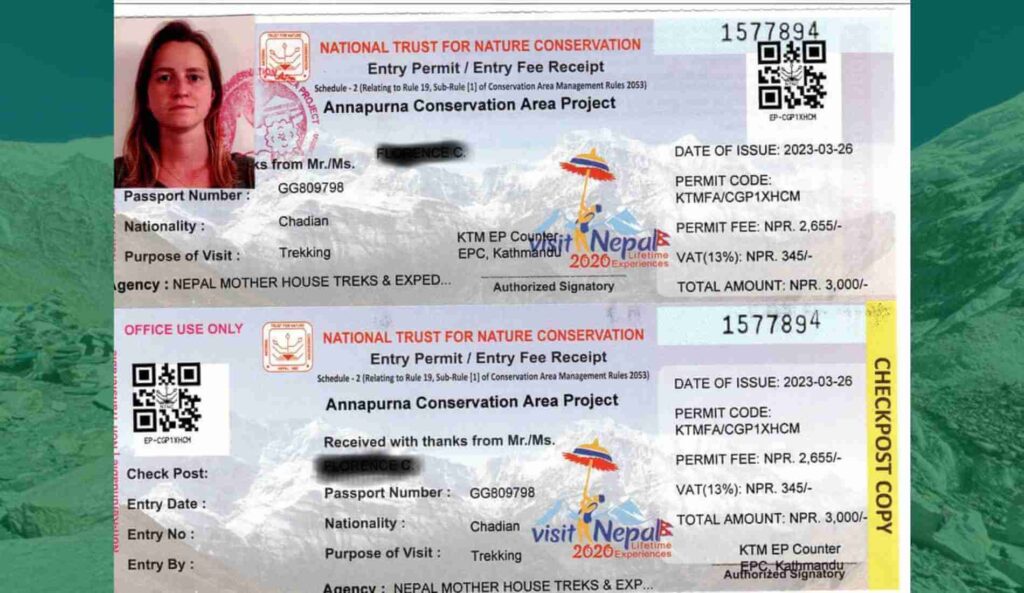
List Of Conservation Areas And Their Fees
SN | Conservation Area | Nepali (NRs.) | SAARC (NRs.) | Foreigners (NRs.) | Child Discount |
1 | Api Nampa Conservation Area | 100 per entry | 500 per entry | 2,000 per entry | Below 10 yrs free |
2 | Annapurna Conservation Area | 100 per entry | 1,000 per entry | 3,000 per entry | Below 10 yrs free |
3 | Blackbuck Conservation Area | 100 per entry | 500 per entry | 2,000 per entry | Below 10 yrs free |
4 | Gaurishanker Conservation Area | 100 per entry | 1,000 per entry | 3,000 per entry | Below 10 yrs free |
5 | Kanchenjunga Conservation Area | 100 per entry | 500 per entry | 2,000 per entry | Below 10 yrs free |
6 | Manaslu Conservation Area | 100 per entry | 1,000 per entry | 3,000 per entry | Below 10 yrs free |
Steps To Get Conservation Area Permits
To obtain a conservation area permit, you must complete a form and submit it with a copy of your passport and a passport-sized photo affixed to the application. You can do this at the Nepal Tourism Board offices in Kathmandu and Pokhara. The Nepal Tourism Board is responsible for issuing these permits.
4. Rural Municipality Trekking Permits
What Are Rural Municipality Permits?
Rural Municipality Permits are special permits required for trekking in certain rural regions of Nepal managed by local municipalities. These permits regulate trekking activities, ensure trekker safety, and support local communities by generating revenue for infrastructure and trail maintenance. The collected fees help develop and sustain the trekking areas.
Regions That Require These Permits
Rural Municipality Permits are necessary for trekking in several remote regions of Nepal. Notable areas that require these permits include:
- Gorkha
- Manaslu
- Dolpo
- Nar Phu Valley
Fees And Application Process
You can obtain Rural Municipality Permits at the starting point of your trek.
Where to Get It: These permits are available at the checkpoints of rural municipalities, such as Lukla in the Everest region.
Cost: The cost varies by area and trek length, but it is usually less than $10 per person per day.
How To Get Trekking Permits In Nepal?
- Contact an Authorized Trekking Agency: Only authorized agencies can apply for permits on behalf of trekkers. Ensure your agency is registered and licensed, such as Tidy Himalaya, a trusted and reputable trekking agency known for its excellent services and experienced guides.
- Form a Group: Trekkers must be in a group of at least two people and accompanied by a licensed trekking guide. Individual trekkers cannot apply for a permit.
- Prepare Necessary Documents:
- Online application form.
- Copy of your passport.
- Valid visa covering the trekking period.
- Name list of trekkers.
- Trekking program schedule.
- Guarantee letter from the agency.
- Agreement with the trekking agency.
- Tax clearance certificate of the agency.
- Insurance documents for both trekkers and accompanying Nepalese staff.
- License from the Ministry of Tourism, Culture and Civil Aviation.
- License from Nepal Rastra Bank for foreign currency exchange.
- Registration certificate of Permanent Account Number.
- Bank payment voucher for permit fees.
- Submit the Application: The authorized trekking agency will handle the submission to the Department of Immigration, fulfilling all necessary formalities.
- Pay the Fees: Permit fees vary by route and are quoted in US dollars but payable in Nepali Rupees. Ensure your visa is valid for the entire trekking period, as permits are not issued beyond the visa expiration date.
Tips For Ensuring A Smooth Application Process for Trekking
Start Early: Begin the permit application process well before your planned trek. This gives you ample time to gather all necessary documents and handle any unexpected delays.
Use a Trusted Agency: Work with a reputable and authorized trekking agency like Tidy Himalaya. They have the experience and expertise to navigate the application process efficiently on your behalf.
Prepare All Documents: Ensure you have all required documents ready, including a copy of your passport, valid visa, passport-sized photos, and your detailed trekking itinerary. Missing documents can cause delays.
Check Permit Fees: Understand the specific fees for your trekking route, which are quoted in US dollars but payable in Nepali rupees. Have the necessary funds ready to avoid payment issues.
Keep Receipts and Copies: Always keep copies of your permit and all submitted documents. Carry these with you during your trek, as you may need to present them at various checkpoints.
Where To Obtain a Trekking Permit In Nepal?
Nepal Tourism Board (NTB) Offices
- Kathmandu: Located at Bhrikuti Mandap.
- Pokhara: NTB office available.
Authorized Trekking Agencies: Restricted Areas: Must be obtained through authorized agencies like Tidy Himalaya.
Checkpoints and Entry Gates: National Parks and Conservation Areas: Available at entry points and checkpoints.
Online: Certain Permits can be applied for and paid for online via official websites.
Rural Municipality Offices: Starting Points: These are available at check posts like Lukla for the Everest region.

Nepal Trekking Permit Fees
TIMS (Trekkers’ Information Management System) Card
Independent Trekkers: NPR 2,000 per person
Group Trekkers: NPR 1,000 per person
Restricted Area Permits
Upper Mustang: USD 500 for the first 10 days, then USD 50 per additional day
Manaslu: USD 70 per week for the first week, then USD 10 per additional day
Dolpo (Upper Dolpo): USD 500 for the first 10 days, then USD 50 per additional day
Conservation Area Permits
Api Nampa Conservation Area: NPR 2,000 per entry for foreigners, NPR 500 for SAARC nationals
Annapurna Conservation Area: NPR 3,000 per entry for foreigners, NPR 1,000 for SAARC nationals
Gaurishanker Conservation Area: NPR 3,000 per entry for foreigners, NPR 1,000 for SAARC nationals
Rural Municipality Permits
Everest Region: $10 per trekker
Makalu Region: $10 per trekker
Common Mistakes To Avoid When Applying For Trekking Permits
- Incomplete Documentation
- Error: Missing necessary documents like passport copies, valid visas, passport-sized photos, or detailed trekking itineraries.
- Solution: Prepare all required documents in advance and double-check that you have everything needed before applying.
- Not Checking Visa Validity
- Error: Applying for permits with a visa that expires before the trek ends.
- Solution: Ensure your visa is valid for the entire duration of your trek. Renew or extend your visa if necessary.
- Ignoring Permit Requirements
- Error: We do not understand the specific permit requirements for different regions.
- Solution: Research the permit requirements for your trekking region and follow the guidelines carefully. Use authorized trekking agencies for restricted areas.
- Insufficient Funds
- Error: Not having enough funds to cover the permit fees, which are often quoted in USD but payable in Nepali Rupees.
- Solution: Check the latest fee structure for your trek and ensure you have the necessary amount in NPR.
- Solo Trekking in Restricted Areas
- Error: Attempting to trek solo in restricted areas where it is not allowed.
- Solution: Form a group with at least two trekkers and a licensed guide for restricted areas.
- Skipping Authorized Agencies
- Error: Trying to apply for restricted area permits without using authorized trekking agencies.
- Solution: Always use authorized agencies to apply for permits in restricted areas to ensure the process is handled correctly.
FAQs
Regions like Upper Mustang, Manaslu, Dolpo, and Nar Phu Valley require restricted-area permits. These areas have special regulations to protect their environment and culture.
National park permits vary in cost. For example, Sagarmatha National Park is NPR 3,000 for foreigners and NPR 1,500 for SAARC nationals. Other parks like Annapurna and Langtang have similar fees.
Some trekking permits can be applied for and paid online through the official websites of the Nepal Tourism Board or respective conservation areas. Check the specific requirements for your trek.
You will need a copy of your passport, a valid visa, passport-sized photos, and a detailed trekking itinerary. Additional documents may be required for restricted areas, such as a group composition list and agency guarantee letter.
The processing time for trekking permits can vary, but it generally takes a few hours to one day if all documents are in order. It’s advisable to apply well in advance to avoid delays.
Yes, trekking without a permit can result in fines, legal action, or being denied entry to trekking areas. Always ensure you have the necessary permits before starting your trek.
Yes, solo trekking is allowed with a TIMS card in most areas. However, solo trekking is not permitted in restricted areas, where you must be part of a group with at least two trekkers and a licensed guide.
Yes, you must carry your trekking permit at all times during your trek. You may be required to show it at various checkpoints along the route.
The validity period of trekking permits varies depending on the type and region. Generally, permits are valid for the duration of your trek as specified in your itinerary.
Yes, some trekking permits can be extended. You must visit the respective office, such as the Nepal Tourism Board, and apply for an extension before your current permit expires.
Trekking without a permit can result in fines, legal consequences, and the barring of entry into trekking areas. It’s essential to obtain and carry the required permits.
No, the TIMS card is generally the same for all trekking routes. However, you must specify your trekking route when applying for the card.
Trekking permits Nepal fees are usually non-refundable. Confirming the refund policy with the issuing authority or your trekking agency before applying is important.

